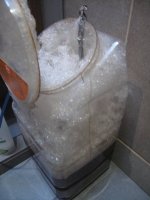chief bigsmoke
Active member
Today I took the next step in the evolution of our growroom and designed our own tea brewing kit.
$20 DIY Tea Brewing Kit
Supplies bought from local pet food store:
- Reclaimed container *sanitized
- Air pump
- Airline tubing
- Air stone
- Tea brewing bag
- A Canadians best friend: Duct tape
Steps
- Clean everything
- Attach pump pieces * don't plug in yet
- Pour unchlorinated water into container. I use Reverse Osmosis water only.
- Place the airstone end of the pump assembly into the bottom of the container. I had to attach a little metal piece to weigh down the airstone. Keeping it in place at the bottom of the container. Make sure you don't restrict the airflow if you have to attach anything to your airline hosing.
- Plug in Air pump assembly
- Add any desired fertilizers to the unchlorinated aerated RO water. I added 1 tbsp of General Organics Bio-thrive vegan Bloom 2-4-4, 2 tbsp of GO's Bio Root 1-1-1, and 1 tbsp of ZHO root innoculant.
- Fill the tea brewing bag with 1.5 cups of Earthworm castings and 4 tbsp of dried Kelp Meal.
- Attach the brewing bag to the duct tape and drop the bag below the waters surface. I tried to place the bag over the airstone.
- Leave for 24-48 hrs. Use a clean wisk or a clean spoon to stir the "poop" soup. 4 times clockwise, then 4 times counter clockwise. *this is a great time to share some of your positive thoughts and prays to your plants as the the bio-dynamic process kicks into overdrive...

I ended up diluting the tea after 48 hrs at a ratio of 1:1 tea to pure RO water and I fed the tea to my special little clones and they are lovin' it. *flooded cloning tray. I thought there would be a stinky smell after brewing for a couple days but there was only a faint smell. I was very happy with that result. I would definitely reccomend this simple system for anyone wanting to super-charge their plants diets. Brewed teas contribute to strong and healthy root systems, which lead to stronger branches and enhanced flowers.
I am so excited for my next cycle knowing that I have a better understanding of what I'm doing and my genetics are now into overdrive. My next batch of clones were giving to me as a mystery by a med-friend that was moving. They know the genetics but all they told me was that they are "Very Special". We both liked the idea of me running them with a blind eye. I was given 4 different clones and each were labelled with different coloured elastics. These colours will be used as the names of the clones as they mature.
We will have a fun time together trying to guess what genetics they are. I was given a couple clues and maybe by the end of the cycle my friend will pipe in with the actual genetics if we have been unsuccessful at guessing ourselves.

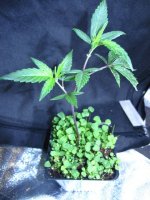
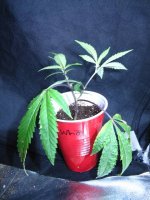
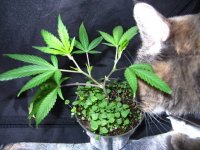
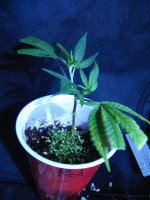





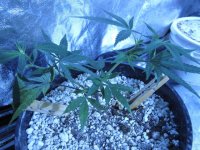


 bio-dynamic magic
bio-dynamic magic
